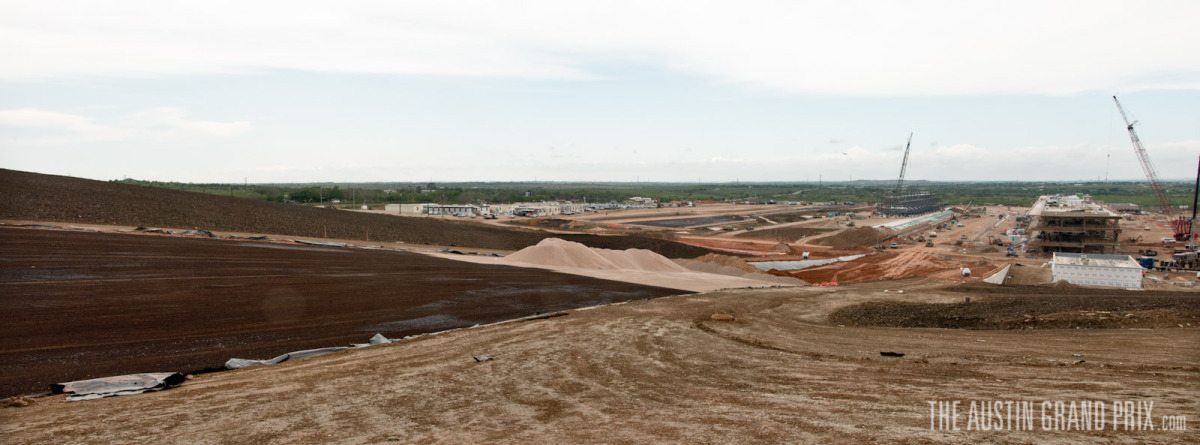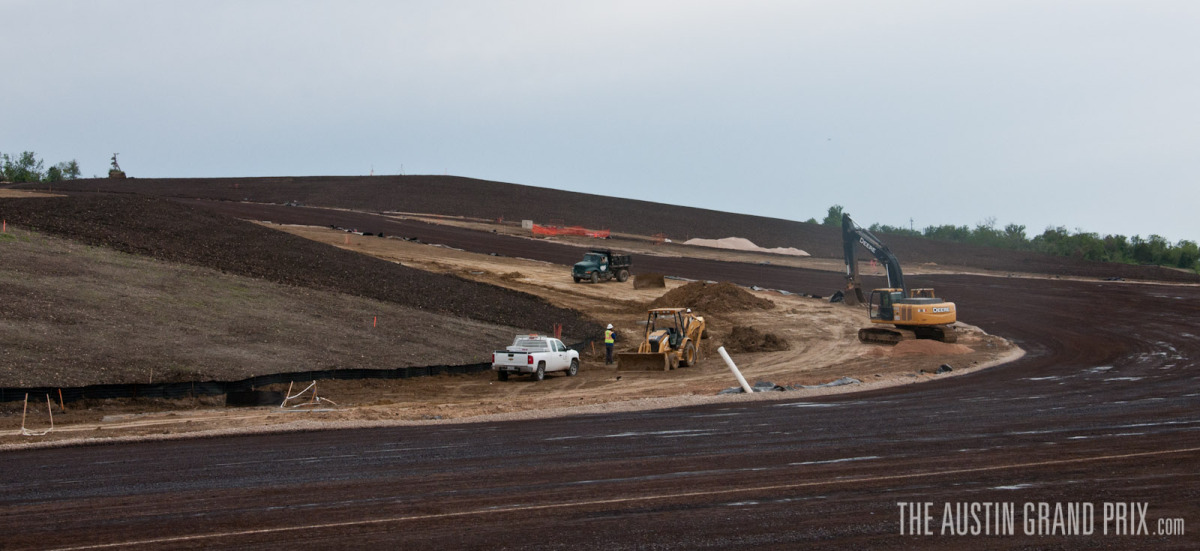(All images by Ron Howard, via @realRonHoward)
The Nurburgring Nordschleife. A 14.189 mile purpose-built racing circuit just south of Cologne, in West-Central Germany. The clockwise loop, with scenic vistas of the Eifel Mountains and the Nurburg castle, would be a perfectly lovely route for a Sunday drive with your family. The dog. A picnic. Deep sigh.
A picnic in a place where between 1928 and 2010, the sum of 68 racing drivers has been killed conquering its corners.
Picture... Exiting the pits, only a lap into the race (bear in mind, one lap of the North 'Ring is equal to roughly four or five laps of a modern circuit), Austrian world champion driver Niki Lauda worked to get heat into his Ferrari's new slicks, after swapping from grooved wet tires. Even though he led the championship at this point, he was running a disappointing 10th place after a slow, wheel spinning start on the wet track, trailing the race's pole sitter, Brit James Hunt.
Upshift, upshift, upshift, full throttle. Brake hard, clutch, blip, downshift. Snap snap snap. In 1976, Formula 1 cars weren't the nanometer perfect technologically terrifying examples of humanity's mastery of physics that they are today. They were hungry, wild and unusually angry animals, barely contained within four wheels. Mechanical pet wolverines.
It's more a sweeping kink than an actual corner. In Gran Turismo 5 you can take it flat out. Supposedly, real racing drivers do, too. The difference between a video game, however realistic, and real life, is that you can't get hurt playing with pixels. But the difference between a normal person playing a video game and a racing driver taking a circuit flat out is that the possibility of pain and death don't factor into the racing driver's conscious mind. They just push. Faster than you can go in real life, and probably faster than you can go in your high-def virtual reality.
And then it happens, and there's nothing you can possibly do to prevent it. Heading into the Bergwerk complex, Niki Lauda's Ferrari snapped around, slammed into the Armco crash barrier, and ricocheted back onto the circuit directly into to the path of hard charging Brett Lunger. Both cars exploded into a firestorm.
Niki Lauda was trapped in the flame engulfed 800 degree cockpit for almost a minute.
Other cars encountered the scene, and Lunger, freed from the wreckage of his Surtees-Ford, along with drivers Artuto Merzario, Guy Edwards and Harald Ertl scrambled to save Lauda's life. It would be more than two full minutes before befuddled race marshals would be able to send trauma support. Conscious, but grievously injured, Niki Lauda was transported to a hospital in nearby Adenau to stabilize his condition, then to long-term care in Manheim, where he slipped into a coma for five days.
Scorched lungs. Disfigured body. Shattered psyche. Most people do not survive trauma of this magnitude.
Six weeks later, he was in the cockpit of a new Ferrari, battling his friend James Hunt for the 1976 Formula 1 World Championship, who had closed the gap during his convalescence.
And this is where the story gets interesting...
Have you seen Grand Theft Auto? Yes, it's a movie, too. It came out in 1977, the same year as Star Wars and a year after (spoiler alert) Niki Lauda lost the championship to James Hunt, after lodging the most improbable almost-comeback in the history of motorsports. Roger Corman produced it. Ron "Opie" Howard wrote, directed and starred in it. It's in Netflix's "Watch It Now" list, for the moment at least. You should do that. Watch it now, that is. It's a goofy Saturday afternoon movie with some well executed banter and even better car chases. I'd go so far as to rate it equal to Smokey and the Bandit, also a product of 1977.
In synopsis, it's the story of a starstruck couple, desperately in love, who decide to elope to Vegas. They are pursued cross-country, Kowalski-style, by the father of the would-be bride and the throngs of cards, cads and characters promised a $25,000 bounty for catching them and preventing the unapproved nuptials. It's a chase movie. Simple.
So when Howard announced he was making a movie called Rush about Lauda and Hunt, it made sense within this context of his entire filmography. It's also a chase. Albeit a multi-million, continent spanning opus rather than a homebrew film project by a first time director with a budget smaller than what it probably costs to deliver the uniforms for the catering crew of the second unit for Rush.
Rush will be released next year. It stars The Avengers' Chris Hemsworth (Thor) as Hunt and Daniel Bruhl, probably best known as Zoller from Inglorious Basterds, as Lauda. It will feature actual, period perfect racing cars like the Ferrari 312-T2 and the fantastically bizarre Tyrell p34, driving on the actual Nurburgring. Racing geeks will squeal and get the vapors.
Can you, racing geek, take your significant other to this film, or will you be sneaking to a matinee on a suspiciously long Tuesday lunch break? And can you, non-racing geek, stomach an entire feature film on the subject, knowing full well the horrors preciously foisted upon unsuspecting ticket holders? Driven... cold shudders. Here's a test. After you finish The Descendents or the second season of Downton Abbey, suggest Senna as your next cinematic couch date. Put the baby to bed, open that $6 bottle of wine you've been hoarding, and prepare to test the waters. Yes, we at The Austin Grand Prix harp on the excellence of this documentary day in and day out. But to introduce someone who might be put off Formula 1 due to its occasion insularity to the real human drama of racing, this is your in. Forget Frankenheimer's Grand Prix; it's nothing more than hardcore car porn disguised as cinema. Senna is more 50 Shades of Grey, or whatever it is my wife is hiding on her Kindle these days. It has depth. And porn.
Did it work? OK. Time for Phase Two. Rewatch A Dangerous Mind, Cinderella Man, Apollo 13, The Paper (so under appreciated, that one), Frost/Nixon, Parenthood, and/or Willow, if you swing that way. Ronnie can tell a compelling story, no? Elicit convincing and utterly human performances from his actors, no? And consider his tutelage. As a boy, he absorbed the humanism of no less than Andy Griffith, and later essentially apprenticed under Spielberg and Lucas (who not only once worked for Carroll Shelby, but also produced several short films on the northern California racing scene in the late 1960s, and has threatened, if you will, to produce and/or direct a film about the Ford vs Ferrari duels of Le Mans). Ron Howard makes some of the best modern Hollywood flicks going. Not all of them are great art, but they are all based in human drama and they are all eminently watchable. Except for those ridiculous Tom Hanks as a geekier version of Indiana Jones fighting an albino masochistic priest, or whatever the hell that was.
At this point, you have the leverage to say, convincingly, "You know, I realize you're maybe not that into Formula 1, but Ron Howard has this movie with that hunk/aweseome dude from The Avengers/Cabin In the Woods/Star Trek, etc. and I think you'd really like it. It's Ron Howard!" If you're swaying a male friend, Rush also stars Olivia Wilde. If you live in Austin or a city that is home to an Alamo Drafthouse, promise a drink or six. If your friend/significant other has no interest in racing whatsoever, lie and tell them it has Neil Peart's best drum solo ever. You can do it.
That was bait. These, however, are the insidious hooks... this story that is too fantastical to be real or even based in reality, these characters that exhibit such awe-inspiring resiliency, or monstrous flaws but who remain sympathetic to our sensibilities... that's how you capture a new F1 fan. Is that Ron Howard's intent? Probably not. He's been nabbed frequently enough by the likes of Will Buxton for fans to realize he's in it for the story, even though he is admittedly a racing fan. He's not an apostle of the Temple of Speed. His intent is to tell a great story and put images on a screen that will, with regard to racing, melt your apathy, heighten your fanaticism, or viscerally engage you to the degree that you become fully invested in the story and its characters, and leave the theater with a changed emotional state. It's the goal of all filmmakers. He hopes. We hope. Beyond that however, as long-time fans of the sport, to know that in 2013 there will be an Oscar contending film about one of our greatest heroes, and one of our greatest anti-heroes (as James Hunt was of equal depth, wit, and spirit, plus he once slept with more than 30 British Airways air hostesses prior to the '76 Japanese Grand Prix, during an epic binge that would have forced Hunter S. Thompson to tap out), it makes us excited to be the Apostles of the Temple of Speed. It's validation beyond the often insular realm we inhabit on Sunday mornings.
Cinema relies on great stories and compelling characters. This particular confluence of story and character is perfect fodder for film. But Formula 1 is rife with great stories and compelling characters. Nuvolari, Clark, Stewart, Prost. There's a depth of color in those characters that I don't think exists in most other walks of life. They blend the devil may care bravado of a rogue with the focused stoicism of a monk. And the battles. The crashes. The passes. The season after season of slugging to finally emerge victorious. It's amazing and perplexing to me that there aren't really any great films about racing. They're either too Hollywood, a la Days of Thunder, to truly capture the essence of the sport, or too up their own arse, as the aforementioned Grand Prix (although it is lovely to look at, and there's James Garner being typically, laconically badass and Lucille Bluth all meee-yow foxy). I'm hopeful that Rush hits the sweet spot between artistry and spectacle, fact and fiction, and moments of honest, raw emotion and fingernail-bending racing scenes. This could be the film that breaks F1 into the modern mainstream by drawing from its almost unbelievable past.
Do us proud, Ron. Better yet, do Niki and James proud. They deserve it.







